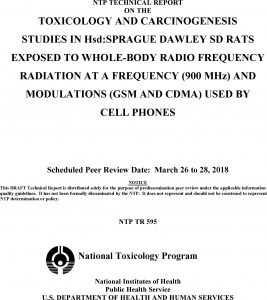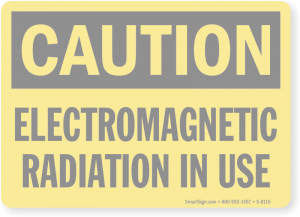
Recent NTP (National Toxicology Program) study on cell phone radiation risks attracted a lot of attention. There are a lot of discussions but not so much real information about. So, let’s look precisely what is it all about.
The NTP Study is about cell phone radiation testing on carcinogenicity
This study is a testing research of the National Toxicology Program, the institution at the National Institute of Health of the US Department of Health. The title of the study is more than optimistic: “Toxicology and Carcinogenesis Studies in … Rats/Mice Exposed to Whole-Body Radio Frequency Radiation at a Frequency and Modulations (GSM and CDMA) Used by Cell Phones”. A bunch of researchers (I have counted about 50 names) was involved, and informed sources say it cost to American taxpayers about $25 million. As the authors state in the introduction to the technical report, the Food and Drug Administration nominated cell phone RFR (radiofrequency radiation) emission for toxicology and carcinogenicity testing in 1999. Wait, wait, say again – in 1999? Oh, OK, just 20 years ago, no hurry for such unimportant issue, just one planet is involved.
Technical reports on the NTP study are available
The study was carried out a couple of years ago and now two technical reports are presented on the site of the NTP [1, 2]. So, we can read them, analyze them, and draw our own conclusions instead of listening to retranslations of some expert assessments. Oh, there are some obstacles, one report is about 270 pages and the other is something over 380 (oops!). But no fear, I am determined to read all of them. And guess what, my courage was quickly rewarded. As it turned out, the reading was not so hard.
The matter is that the most part of the study, something over 90%, is just not relevant to the issue of cell phone radiation. I’ll explain. As you may know, and as authors of the study exactly know (they cite it), the SAR (Specific Absorption Rate) limit adopted by the FCC is 1.6 W/kg as a peak spatial-average SAR for humans. And this number is applied as a safety limit to cell phone radiation in the US. In Europe and most other parts of the world SAR limit is 2 W/kg. According to ICNIRP, this is kind of safety limit, after which explicit thermal effects in biological tissues occur, and tissue temperature increases more than 1 0C under the exposure. So, you could hardly find any commercial cell phone with SAR value over 1.6 W/kg. Even the most aggressive models, say iPhones (oops!) have SAR about 1.19 W/kg. And if the study presumes to test “toxicity and carcinogenicity of cell phone radiation”, you naturally expect that real cell phone radiation parameters will be used. Correct? Not the case here. Let’s see. The researchers used two relevant RFR frequencies (900 and 1900 MHz), two relevant types of modulations (GSM and CDMA), and two different periods of discontinuous exposure of lab animals (28 days and 2 years). But (and it’s a very big but) they used unreal high intensity of RFR. Mice were exposed during a 28-day period to RFR with SAR 5; 10 or 15 W/kg, and during a 2-year period to radiation with SAR 2.5; 5 or 10 W/kg. So, none of the SAR was under the FCC or ICNIRP limits for cell phone radiation, and all of them should be classified as thermal but not as low intensity radiation. What’s about the experiments on rats? Radiation with SAR 3; 6 and 9 W/kg was used in a 28-day rat study, and RFR with SAR 1.5; 3 and 6 W/kg was used in a 2-year rat study. So, here they used (kind of accidently?) at least one exposure under the FCC / ICNIRP limits. And strictly speaking, only the data from the experiment with 1.5 W/kg RFR can be classified as a real test on cell phone radiation risks.
What’s the problem with the NTP study design?
You would say, hey, what’s the problem? Higher SAR / intensity of radiation induces stronger effects. They just wanted to overload the animals with radiation to get more reliable results. Not the case here again. And they should know it.

First, yet in 2015 my colleagues and I published a meta-analysis of all available on that time scientific articles on oxidative effects of radiofrequency radiation [3]. We demonstrated that while the majority (93%) of studies on low intensity RFR revealed significant oxidative effects in living things, studies on high intensity RFR did not demonstrate oxidative effects at all. Oxidative stress, by the way, is a direct way to oxidative damage of DNA, mutagenesis and carcinogenesis. We don’t know why the effect depends on the intensity of RFR in such a way. Maybe it’s something like when you fry a chicken (thermal effects), subtle biochemical reactions (non-thermal effects) inside the flesh just blow away. Anyway, if you want to test cell phone radiation, use cell phone radiation, not microwave oven radiation.
Second, maybe even more important issue with that NTP study design is its virtual uselessness even if it does demonstrate carcinogenic effects of used sets of exposure. The wireless industry / FCC / ICNIRP just will say, it’s OK, but it’s not about our busyness, it’s all about high intensity RFR, which we don’t use in our technologies at all. Actually, ICNIRP already said something like that (see here). And guess what. Formally they are right because almost the whole NTP study is about thermal intensities of RFR. (The other thing is why the design of the NTP study turned out to be so comfortable for the wireless industry. To put it bluntly, I don’t believe in so screaming incompetence of the NTP guys.) The NTP researchers even used “subcutaneously implanted microchips” to record body temperature of the animals under the thermal intensities of RFR. And magic, “higher body temperatures were observed” in 6 or more W/kg RFR exposed animals [1]. Do these data really cost $25 million of American taxpayers? Come on! Most people over the world carry out such experiments on a daily basis for free. Just put some flesh into the microwave oven and check the temperature in a few minutes touching the thing.
Third, only tiny part of the study, when they used 1.5 W/kg RFR exposure is somehow relevant to the aim of the testing. (Even this SAR is actually on the edge of the FCC limit.) But here I see something strange again. Let’s look at 2-year survival data on rats. You expect kind of high/normal survival rate in control unexposed animals and some possible effects in the exposed groups. Right? Well, the control group of albino rat line used in the study had 2-year survival rate among males just about 28%. It means that more than 2/3 of control rats died “naturally” at the end of the experiment. Did researchers expect to reveal any effects of RFR exposure on that background? I am not sure. But they managed to do it. Magically, RFR exposed groups of male rats had survival rates something about twice or even higher than unexposed control! Do you believe? It’s kind of if your body is being exposed to intensive RFR during years on a daily basis, say you are living under a powerful radar system, you will live much longer. Cool! The only issue here is that these data are not consistent with medical conditions of people working with radars or living near powerful cell phone base station (see our review on the issue [4]). Actually, I have some primitive explanation of that paradox with survival data in the NTP study. Most control male rats died at the end of experiment due to chronic progressive nephropathy (a disease of the kidney) according to the study report. Periodical exposure of rats to intensive RFR definitely warmed up rat intestines, and that somehow could be preventive for that kidney pathology, say if it developed due to chronic overcooling of rats in the experimental chambers. And exposed animals can really live longer coping with the kidney pathology. Something like that.
Value of the NTP study
OK, the $25 million question is: Does the NTP study have some scientific and practical value for cell phone radiation issue despite all these (suspicious) flaws. Yes, definitely. The data on the rats exposed to 1.5 W/kg RFR are valuable. And they are more than interesting. The rats exposed to 1.5W/kg GSM or CDMA radiofrequency radiation had statistically significantly increased levels of both cancer and non-cancer pathologies. (I have conducted my own statistical analysis the data presented in the report.) Say, 3.3% of GSM RFR exposed male rats (3 from 90) and 3.3% of CDMA RFR exposed female rats (also 3 from 90) developed malignant glioma (brain cancer) while none of 180 control animals had it. By the way, female rats exposed to higher/thermal levels of CDMA RFR did not develop brain cancer as well as control animals. Two percent of male rats exposed to GSM or CDMA RFR developed malignant schwannoma of the heart while none of control animals had it [1]. Both types of cancers are very rare and its appearance in rats exposed under “safety limits” for humans is very indicative.

Non-cancer pathologies of prostate gland appeared in 14.4% of 1.5 W/kg GSM exposed male rats compared to 5.5% of control animals (2.6 times difference). And pituitary gland pathologies have been found in 31.1% of GSM exposed male rats compared to 19.1% of control animals (1.6 times difference). Cardiomyopathy, non-cancer heart pathology, appeared in female rats exposed to 1.5 W/kg GSM RFR 2.3 times more often than in control (10% in the exposed group against 4.4% in the control) [1].
So, we have something on a plate from this study. And we can only imagine how much more valuable it could be under relevant study design and conditions.
Precursor of the NTP study, US Air Force radar radiation study
You may be interested to know that American taxpayers already spent money on that issue before. That was not exactly a testing of cell phone’s but radar’s radiation which is actually very similar for its physical parameters and biological effects. That was a testing of long-term effects of low intensity RFR/microwaves (2,450 MHz pulsed radiation with SAR 0.15-0.4 W/kg) on lab rats under the US Air Force contract yet at the beginning of 1990th [5]. Pay attention, here real low intensity RFR, which corresponds to modern FCC / ICNIRP safety limits, was used.

I guess the idea was to check physiological/medical conditions of pilots under long-term RFR exposure from Air Force radar systems. Researchers from Bioelectromagnetics Research Laboratory at the University of Washington, Seattle checked 155 (!) biomedical parameters of a hundred exposed rats after 2 years of exposure (the other hundred animals were unexposed control). The parameters included tests on behavior, immunology, hematology, histopathology of all organs and tissues, longevity and others. After 2 years of discontinuous exposure of the rats some parameters, including behavioral tests, were relatively OK, some were not. By the way, longevity of exposed rats in that study was close to control. The most significant effects were observed in histopathology: primary cancers were detected in the exposed rats 3.6 times more often than in control animals. Additionally, metastatic cancers were detected in the exposed rats 2 times more often than in the control. It means that RFR exposed animals had much more cancers and those cancers developed faster under the exposure. Say, level of lymph nodes’ malignant pathologies increased due to the exposure 5 times, thyroid cancers – 3 times, and also cancers of ureter and urin bladder appeared in the exposed rats while these cancers were not detected in the control animals at all. You’ll be amazed with the conclusions of this study: “The overall results indicate that there are no definitive, biologically significant effects (underlined by me) on rats chronically exposed to this form of microwaves. Positive findings [on cancer effects] need further independent experimental evaluation”. Let me transform it in plain language: pilots can fly under radar radiation though cancers will increase significantly. I am just interested how many American or other countries’ pilots know about this study. And what would the NTP expert panel conclude on carcinogenic effects in this study? Is it relevant to cell phone radiation risks?
Be informed and healthy.
Take care,
Dr. Igor Yakymenko
References:
- Toxicology and carcinogenesis studies in Hsd:Sprague Dawley SD rats exposed to whole-body radio frequency radiation at a frequency (900 MHz) and modulations (GSM and CDMA) used by cell phones, 2018, National Toxicology Program. 381 p.
- Toxicology and carcinogenesis studies in B6C3F1/N mice exposed to whole-body radio frequency radiation at a frequency (1,900 MHz) and modulations (GSM and CDMA) used by cell phones, 2018, National Toxicology Program. 270 p.
- Yakymenko I, Tsybulin O, Sidorik E, Henshel D, Kyrylenko O, Kyrylenko S. Oxidative mechanisms of biological activity of low-intensity radiofrequency radiation. Electromagn Biol Med 2016; 35: 186-202.
- Yakymenko I, Sidorik E, Kyrylenko S, Chekhun V. Long-term exposure to microwave radiation provokes cancer growth: evidences from radars and mobile communication systems. Exp Oncol 2011; 33: 62-70.
- Chou C K, Guy A W, Kunz L L, Johnson R B, Crowley J J, Krupp J H. Long-term, low-level microwave irradiation of rats. Bioelectromagnetics 1992; 13: 469-96.



